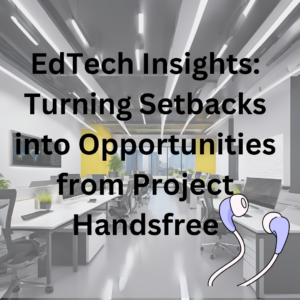In 2006, I started my first EdTech initiative, Project Handsfree for Teachers. My goal was ambitious yet simple: to revolutionize the way teachers approached remedial and advanced learning. The idea was to take these sessions out of the traditional classroom and into a computer lab where students could engage in online study. This would free up teachers from repetitive tasks, allowing them to focus on their core teaching responsibilities.
The idea was to take these sessions out of the traditional classroom and into a computer lab where students could engage in online study. This would free up teachers from repetitive tasks, allowing them to focus on their core teaching responsibilities.
The pilot was launched in Savashala, Surendranagar, Gujarat. The results were promising—teachers felt relieved, and students showed noticeable improvement. But the reality in India then was starkly different. Unlike in the U.S., where EdTech was gaining traction, India faced a massive technology gap. Most students and teachers were unfamiliar with computers, making the project feel more like a distraction than an aid.
To address this, we added a personal contact layer where teachers connected with students before shifting them to online modules. Even with this adjustment, the project failed. For years, I saw this as a hard blow. But when I look back today, I realize it wasn’t the failure of the project itself—it was the failure of our marketing campaign. The product worked; it just didn’t reach or resonate with the right audience in the right way.
Here’s what I learned from the experience and how it continues to guide my approach to EdTech today:
1. Ask “Why” Until You Find the Root Cause
When the project didn’t scale, I dug deeper, asking “Why?” multiple times.
- Why didn’t it scale?
The timing wasn’t right. Rural India wasn’t ready for tech-based education. We were introducing a solution to a problem that wasn’t yet recognized. - Why didn’t it connect with the audience?
Our messaging missed the mark. We positioned it as a tool for teachers, but the real beneficiaries were students struggling with subjects like math.
This constant questioning helped me uncover the real gaps in our approach.
2. Identify the Real Audience
We marketed the project to school leaders and teachers, but the actual beneficiaries were students. In hindsight, this mismatch was a critical mistake. Schools saw it as an unnecessary expense when teachers were already on their payroll. Additionally, in 2006, neither mobile phones nor computers were widespread. Even today, such gaps still exist in some parts of India.
The takeaway? Clearly defining and engaging the right audience is essential. Misalignment can lead even the best ideas astray.
3. Craft a Narrative That Resonates
Our narrative focused on how Project Handsfree would relieve teachers of repetitive tasks. However, schools saw this as redundant—they believed such tasks were the teacher’s responsibility. The narrative didn’t address the value it brought to students or parents, who could have been our strongest advocates.
Today, I understand that every stakeholder—schools, parents, teachers, and students—needs to see how the solution directly benefits them. A strong, clear story is the foundation of any successful marketing campaign.
4. Spot the Gaps and Own Them
Failures often reveal blind spots. For us, the gaps ranged from unclear messaging to misidentified targets. By acknowledging these gaps, I realized how we could have repositioned the project to better align with its goals.
Owning these gaps isn’t a sign of weakness—it’s a chance to innovate and improve.
5. Repurpose What Works
Every failure leaves behind sparks of potential. Despite its shortcomings, Project Handsfree worked for students and freed up teachers’ time. If we had repurposed these aspects, perhaps through a phased rollout or by targeting a different demographic, the project might have succeeded.
Failure isn’t a full stop—it’s a comma. Repurposing what works is often the key to turning a setback into an opportunity.
The Big Lesson: It Wasn’t the Project, It Was the Campaign
Looking back, I see that Project Handsfree wasn’t a failed idea—it was a poorly marketed one. The product had potential, but the messaging didn’t align with the needs of the audience. This realization has profoundly shaped how I approach every project today.
For EdTech entrepreneurs, the lesson is clear: great ideas need great storytelling. The best products won’t succeed if they fail to connect with the right people in the right way.
Moving Forward
Every setback sets the stage for a stronger comeback. The real success lies not in avoiding failure but in how you respond to it. Analyze, adapt, and innovate—because every failure is a step closer to building something remarkable.
Remember, it’s not the end of the road—it’s just a turn.

